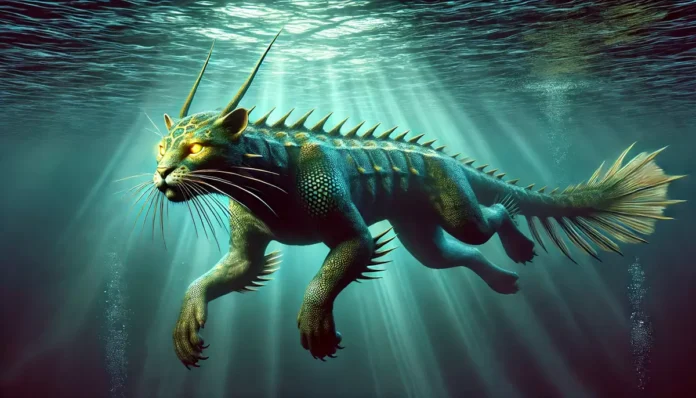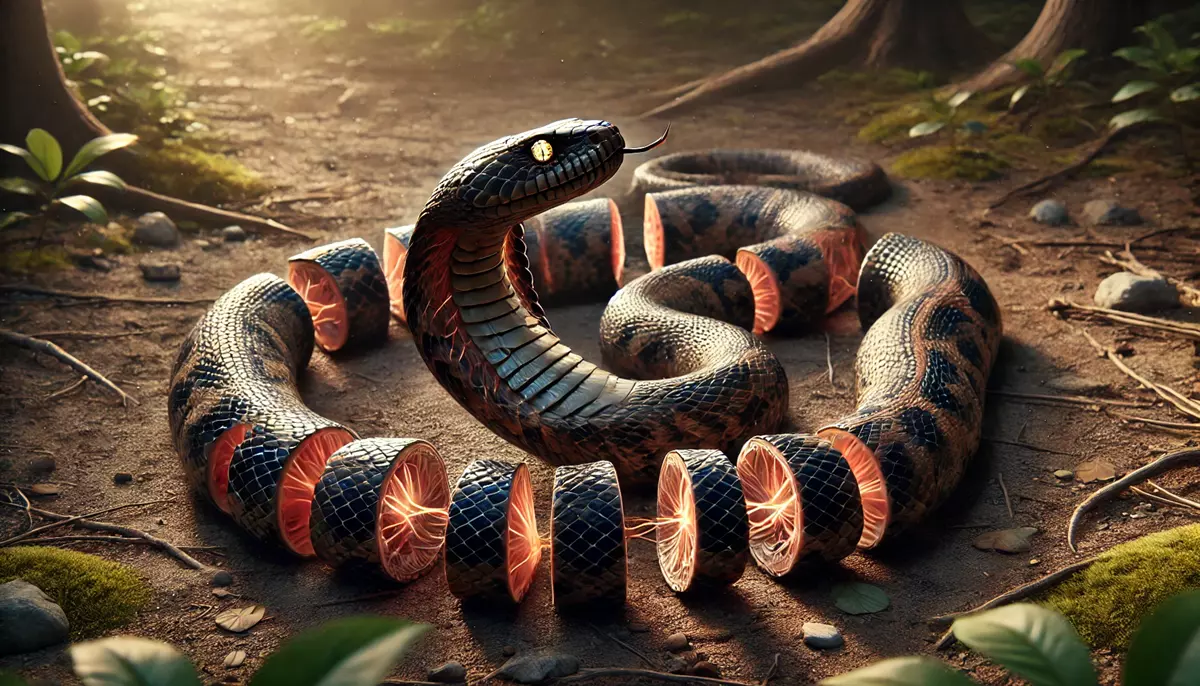Introduction
Mishipeshu, also known as the Underwater Panther, is a fearsome and revered figure in Anishinaabe and other Indigenous cultures of the Great Lakes region. This powerful being embodies the duality of nature, representing destruction and protection, danger and abundance.
Mishipeshu is described as a hybrid creature, combining the features of a lynx, serpent, and dragon, with scales, horns, and razor-sharp claws. It is said to inhabit deep lakes and rivers, guarding precious minerals and controlling the waters’ currents. Stories of Mishipeshu serve as cautionary tales, warning against disrespecting the natural world.
Despite its terrifying reputation, Mishipeshu also acts as a guardian, maintaining balance in the natural and spiritual realms. The creature remains a central figure in the folklore and traditions of the Anishinaabe and neighboring cultures.
History/Origin
The origins of Mishipeshu trace back to the Anishinaabe, a group of Indigenous peoples in the Great Lakes region, including the Ojibwe, Odawa, and Potawatomi. Mishipeshu is considered one of the most powerful Manitou (spirits) and holds a prominent place in their cosmology.
Mishipeshu’s role is tied to its dominion over water, minerals, and the underworld. The creature’s connection to copper, a sacred material for the Anishinaabe, emphasizes its protective role. Mishipeshu is believed to guard these sacred resources, ensuring they are not misused or desecrated.
“Mishipeshu, the guardian of waters, prowls beneath the waves, its scales gleaming with the earth’s treasures.” (Anishinaabe Oral Tradition)
The legend of Mishipeshu evolved as the Great Lakes region became a hub of trade and cultural exchange. Its presence in petroglyphs and pictographs highlights its enduring significance in Indigenous art and spirituality.
Name Meaning
The name Mishipeshu translates to “Great Lynx” or “Great Water Spirit” in the Ojibwe language.
This name encapsulates the creature’s dual nature, blending feline agility and cunning with aquatic power and mysticism. Mishipeshu’s name also reflects its role as both a protector and a potential threat, embodying the unpredictable forces of water and the underworld.
Appearance
Mishipeshu’s unique and fearsome appearance is a combination of various powerful creatures:
Body: The sleek, muscular form of a lynx, covered in shimmering scales.
Tail: A long, serpentine tail capable of whipping with incredible force.
Horns: Prominent, curved horns resembling those of a bison or dragon.
Claws: Razor-sharp claws that can tear through rock and water alike.
Eyes: Glowing eyes that pierce through the darkness of deep waters.
Mishipeshu’s hybrid features symbolize its dominance over land, water, and the spiritual realm, making it one of the most enigmatic creatures in Indigenous mythology.
Background Story
Mishipeshu is said to have been created by the Creator as a guardian of water and sacred minerals. Its role is to maintain the balance of natural forces, ensuring that humanity respects and honors these resources.

According to the Anishinaabe, Mishipeshu’s wrath is provoked when humans act with greed or disrespect toward nature. It is believed that storms, floods, and other natural disasters are manifestations of Mishipeshu’s anger.
“From the depths, Mishipeshu rises, a protector and punisher, ensuring the waters remain pure and sacred.” (Ojibwe Sacred Stories)
Despite its fearsome reputation, Mishipeshu also guides those who approach nature with reverence, offering protection and blessings to those who honor its domain.
Famous Folklore Stories
The Copper Theft and Mishipeshu’s Wrath
In the 17th century, four Ojibwe men embarked on a journey to Michipicoten Island, the sacred dwelling of Mishipeshu, to retrieve copper. Ignoring tribal taboos, they sought the precious metal guarded by the Underwater Panther.
“The very second they pushed off and backed into the water with their canoe, the eerie voice of the water panther surrounded them.” (Jesuit Relations, Volume LIV, Chapter XI, Section 26, 1899)
As they paddled away, Mishipeshu’s growls echoed around them, accusing them of stealing his children’s playthings. One by one, misfortune befell them; all four perished before reaching their village. The last survivor recounted their ordeal with his dying breath, serving as a cautionary tale against desecrating sacred sites.
The Shaman’s Pact with Mishipeshu
A renowned shaman, desiring greater power, ventured to Lake Superior to summon Mishipeshu. Through rituals and offerings, he sought the Underwater Panther’s favor.
“Mishipeshu, the guardian of waters, prowls beneath the waves, its scales gleaming with the earth’s treasures.” (Anishinaabe Oral Tradition)
Mishipeshu appeared, granting the shaman enhanced abilities but demanded a heavy price: the lives of his wife and son. The shaman agreed, and upon returning home, his family succumbed to mysterious illnesses. Though he gained power, he lived out his days in sorrow and isolation, a reminder of the perils of bargaining with powerful spirits.
Cultural Impact
Mishipeshu, the Underwater Panther, holds a significant place in the cultural heritage of the Anishinaabe and other Indigenous peoples of the Great Lakes region. Its influence permeates various aspects of art, storytelling, and spiritual practices, reflecting the deep connection between these communities and the natural world.
Artistic Representations
Mishipeshu frequently appears in traditional and contemporary Indigenous art. Notably, Ojibwe artist Norval Morrisseau depicted the Underwater Panther in his Woodlands style paintings, drawing inspiration from Ojibwe oral history and cosmology. These artworks serve to preserve and communicate cultural narratives, ensuring the legend of Mishipeshu endures across generations.
Symbol of Cultural Resilience
The imagery of Mishipeshu has been utilized during periods of cultural upheaval as a symbol of strength and resilience. Artifacts such as quilled shoulder satchels and twined bags featuring the Underwater Panther were created during times when the Anishinaabe faced significant challenges, including changes in trade and alliances. These items called upon traditional imagery to evoke a sense of Anishinaabe power and identity.
Educational and Interpretive Programs
Mishipeshu’s legend is also featured in educational programs and interpretive centers, where it serves as a gateway to understanding Indigenous worldviews and the importance of water in their cultures. Through these platforms, the story of the Underwater Panther educates broader audiences about the rich traditions and beliefs of the Anishinaabe and related peoples.
Similar Beasts
Mishipeshu shares characteristics with other mythical creatures around the world that embody its fierce guardianship of water, treasures, and the balance of nature. These creatures echo its hybrid appearance and powerful role in folklore.
Nguruvilu (Mapuche Mythology, Chile)
The Nguruvilu, or “Fox Snake,” is a water-dwelling creature with a long, serpentine body and feline traits, similar to Mishipeshu’s lynx-like form. It is said to cause whirlpools and protect rivers from intruders, punishing those who disrespect the waterways.
Nian (Chinese Mythology)
The Nian, a hybrid beast with feline and reptilian traits, mirrors Mishipeshu’s role as both protector and destroyer. Associated with water and feared for its ferocity, the Nian is said to emerge during significant natural events, akin to Mishipeshu’s connection to storms and floods.
Amphisbaina (Greco-Roman Mythology)
This serpent-like creature with a horned or dragon-like head embodies the serpentine features of Mishipeshu. Known for its duality and territorial nature, the Amphisbaina was believed to guard treasures and sacred spaces, echoing Mishipeshu’s role as a guardian of minerals and lakes.
Nüwa’s Serpent Form (Chinese Mythology)
Nüwa, a serpentine goddess often depicted with dragon-like scales, shares Mishipeshu’s hybrid appearance and role in maintaining natural harmony. While Nüwa creates and protects, Mishipeshu enforces balance through guardianship, illustrating a shared reverence for nature’s power.
Religion/Ritual
Guardian of Sacred Resources
As the protector of copper and other minerals, Mishipeshu is revered in rituals that honor the earth’s resources. Offerings and prayers are made to appease the Underwater Panther, seeking permission to utilize these materials and expressing gratitude for their provision.
Ceremonial Depictions
Mishipeshu is often featured in ceremonial items, such as drums, clothing, and ritual paraphernalia. These depictions serve to invoke the spirit’s presence during ceremonies, seeking its guidance and protection. The integration of Mishipeshu into these practices underscores its significance in maintaining spiritual balance.
Shaking Tent Ceremony
In some traditions, the Shaking Tent ceremony—a ritual used to communicate with spirits—involves invoking Mishipeshu. Participants seek the Underwater Panther’s wisdom, particularly concerning matters related to water, healing, and protection. This ceremony highlights the deep spiritual connection between the people and Mishipeshu.
Scientific or Rational Explanations
Natural Water Hazards
The Great Lakes are known for their unpredictable weather, strong currents, and hidden dangers. Sudden storms, whirlpools, and treacherous waters could have been attributed to Mishipeshu’s wrath, serving as explanations for unexplained drownings or disappearances.
Copper Deposits
The region’s rich copper deposits, often found near water bodies, may have reinforced the association of Mishipeshu with both water and valuable minerals. The prohibition against taking copper from certain areas, under the belief that it was guarded by Mishipeshu, could have been a means to protect these resources from over-exploitation.
Wildlife Encounters
Sightings of large aquatic animals, such as otters or large fish, might have been misinterpreted or embellished over time, contributing to the imagery of a powerful water-dwelling creature like Mishipeshu. These encounters, combined with the human tendency to mythologize the unknown, could have given rise to the legend.
Modern Cultural References
“Grimm” – Season 4, Episode 18: “Mishipeshu”
In this episode of the supernatural TV series “Grimm,” the plot centers around a Native American legend involving Mishipeshu. The creature’s spirit possesses individuals, leading to a series of mysterious events that the protagonists must unravel
“Mishipeshu: The Legend of Grand Island” by Matthew F. Winn
This novel delves into the mysteries surrounding the water panther, blending folklore with a thrilling narrative set around Lake Superior. The story brings Mishipeshu into a contemporary setting, introducing the legend to modern readers.
“The Mishipeshu and Other Native Bedtime Stories” by Brittany Hamley
Part of “The Woods Devil and Other Northern Bedtime Stories Collection,” this book offers a poetic exploration of Native spirits, including Mishipeshu. Aimed at sparking imagination, it presents the water panther’s tale alongside other Indigenous legends.









